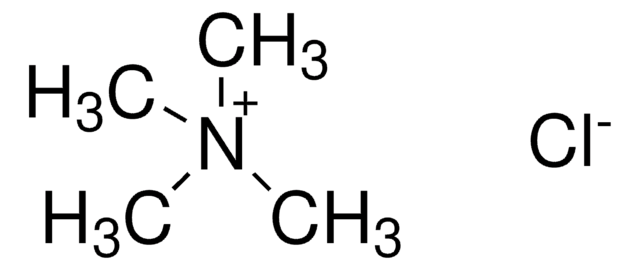T3038
Trizma® hydrochloride solution
1 M, BioReagent, for molecular biology
Sinônimo(s):
Tris hydrochloride solution
About This Item
Produtos recomendados
grau
for molecular biology
for molecular biology
Nível de qualidade
esterilidade
0.2 μm filtered
linha de produto
BioReagent
forma
solution
concentração
1 M
Impurezas
DNase, RNase, NICKase and protease, none detected
pH
8.0
aplicação(ões)
agriculture
cadeia de caracteres SMILES
Cl.NC(CO)(CO)CO
InChI
1S/C4H11NO3.ClH/c5-4(1-6,2-7)3-8;/h6-8H,1-3,5H2;1H
chave InChI
QKNYBSVHEMOAJP-UHFFFAOYSA-N
Procurando produtos similares? Visita Guia de comparação de produtos
Descrição geral
Aplicação
- As buffer for the 2-D electrophoresis of rat fibroblast cell.
- As buffer for the rapid isolation of high molecular weight plant DNA (50,000 base pairs or more in length).
- Selective immunoprecipitation of biotin-labeled DNA with antibiotin IgG and Staphylococcus sp.
For precise applications, use a carefully calibrated pH meter with a glass/calomel combination electrode.
Outras notas
Informações legais
Código de classe de armazenamento
10 - Combustible liquids
Classe de risco de água (WGK)
WGK 2
Ponto de fulgor (°F)
Not applicable
Ponto de fulgor (°C)
Not applicable
Equipamento de proteção individual
Eyeshields, Gloves, type ABEK (EN14387) respirator filter
Certificados de análise (COA)
Busque Certificados de análise (COA) digitando o Número do Lote do produto. Os números de lote e remessa podem ser encontrados no rótulo de um produto após a palavra “Lot” ou “Batch”.
Já possui este produto?
Encontre a documentação dos produtos que você adquiriu recentemente na biblioteca de documentos.
Os clientes também visualizaram
Nossa equipe de cientistas tem experiência em todas as áreas de pesquisa, incluindo Life Sciences, ciência de materiais, síntese química, cromatografia, química analítica e muitas outras.
Entre em contato com a assistência técnica










